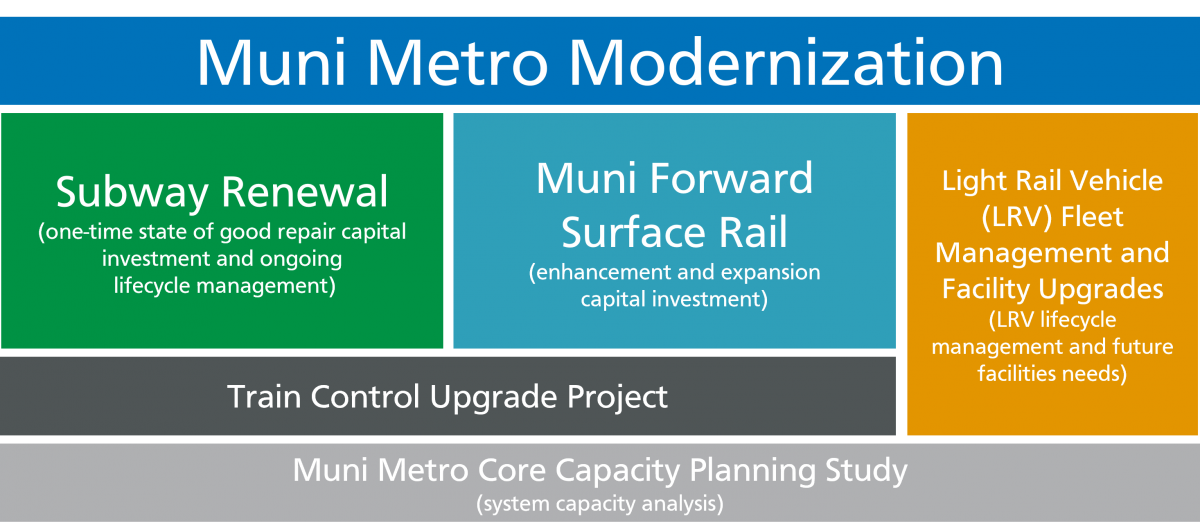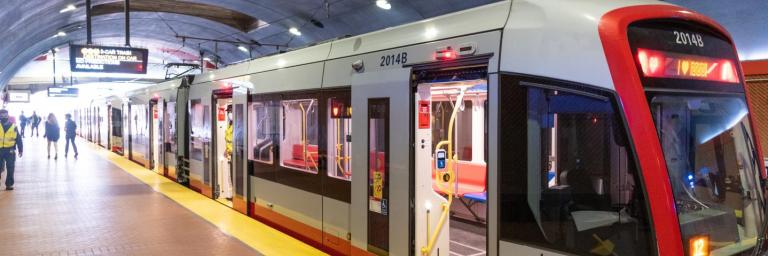San Francisco's Muni Metro subway system moves our highest volumes of customers through the core of the city. The Muni Metro system operates on fixed surface railways and underground tunnels from Embarcadero to West Portal in a subway that was constructed between 50 to 100 years ago and much of the infrastructure that keeps our system moving is original.
SFMTA’s vision for transit in San Francisco is frequent, dependable service for our customers. Riders will experience short, uninterrupted trips because the system will be free from congestion and delays caused by sub-system and equipment failures. Aging critical infrastructure that keeps the system moving will be replaced with new state-of-the-art equipment, and routine maintenance will ensure the system is kept in a state of good repair. The new infrastructure will also have the capacity to allow us to expand our capacity and improve reliability to meet the needs of our riders, preparing the system to meet future demands as San Francisco grows. Modern stations, customer information and amenities will attract riders and increase comfort and safety at all stages of our customers’ journey.
We would do both as part of holistic program (as we replace outdated/aging infrastructure, we would replace it with modern infrastructure that allows higher capacity), charting a course from current short-term/incremental improvements to long term transformative ones.

Muni Metro Modernization provides an overarching framework for how SFMTA will achieve the vision above. This vision requires a tiered approach: foundational state of good repair upgrades and replacement of aging systems through our Subway Renewal Program, complemented by innovative service changes to improve capacity in the subway and capital projects to improve reliability to our surface rail through the Muni Forward program. The Train Control Upgrade Project bridges state of good repair improvements and system capacity improvements by replacing a 20+ year old system in the subway and expanding new technology to the surface. Finally, strategic investment in our light rail fleet and facilities will be critical.
Subway Renewal Program
The Subway Renewal Program lays out a systematic approach to capital upgrades over the next ten years, targeting strategic repair, replacement and enhancements of the most critical systems. This work will improve our subway’s resilience and prepare it for the demands of the future.
Additionally, the program provides a framework for future capital work by emphasizing continuous upgrades, as well as identifying replacement needs early and ensuring they are addressed promptly. Much of the critical subway infrastructure items we will replace, upgrade or enhance over the next ten years include things that customers never see, but are essential to system safety, efficiency and reliability. These include replacing tangent (straight-line) track, crossover tracks and switches, upgrading our electrical systems in the subway stations, enhancing ventilation and replacing and upgrading our train control system. Along with these "behind the scenes" improvements, we will also update and upgrade signage and wayfinding elements.
Muni Forward
Muni Forward integrates long-and near-term capital projects that accompany day-to-day service planning of the system to improve transit travel times and reliability. SFMTA plans to advance multiple projects through a scaffolded approach – advancing planning work associated with ConnectSF recommendations, Geary Rapid phase 2, surface rail improvements that complement the Subway Renewal program, three-car N Judah and bus enhancements that support the Rapid network expansion. SFMTA has also worked to make Temporary Emergency Transit Lanes permanent and is identifying and implementing hot spot improvement projects to further tweak and continuously improve service.
Train Control Upgrade Project
The SFMTA is working to grow light rail ridership and expand service frequency. Our outdated centralized train control system is under constant pressure and is increasingly operating beyond the capacity for which it was designed nearly three decades ago. To increase rail network capacity, the SFMTA is implementing the Train Control Upgrade Project (TCUP). TCUP possesses the greatest potential of any single investment to effectively and significantly bolster system efficiency. The SFMTA must grow rail network capacity to retain current ridership as well as serve and attract future ridership.
Muni Metro Core Capacity Planning Study
The Muni Metro Core Capacity Planning Study sets out to answer critical planning questions for our system -- What is our future higher capacity system? What is the program of infrastructure projects and service that will get us there? How do we measure success? Building upon the vision in the ConnectSF Transit Strategy, the Core Capacity Planning Study will develop a comprehensive long-term strategy for expanding the capacity of the Muni Metro system including identifying innovative service changes that will improve operations and reliability in the subway.
Building Upon Our Success
As we work to restore and adjust Muni Metro service to new travel patterns during recovery, we’ll continue to build upon good work done and lessons learned throughout the pandemic. It is well-documented that Muni Metro has been plagued with service reliability problems for decades. We know what the issues with Muni Metro are—and we have the tools and programs in place to improve the system. From capital improvements like train control system upgrades to improving our service performance by piloting projects like the J Church Surface-only Pilot, we’re working to improve the reliability and service of the Muni Metro both in the near and long term.
As an example, after we initially restored Muni Metro service in August 2020, we quickly discovered that we needed to make significant repairs in the subway, particularly in the Eureka Curve near Castro Station.
This work included:
- Replacing and repairing defective splices on the overhead lines, eliminating slow zones
- Grinding rail to reduce wear and improve ride quality
- Replacing track switch machinery in the turnaround area east of Embarcadero to ensure smooth operations
- Replacing ballast in the Eureka Curve Tunnel to address rail stability and drainage issues
- Upgrading subway lighting to allow for improved visibility during maintenance work and emergency response
- Providing customer Wi-Fi access
